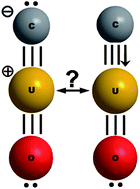On the maximum bond multiplicity of carbon: unusual C≣U quadruple bonding in molecular CUO†
Abstract
Carbon is known to form single, double and triple bonds. An educated search led us to a novel view on the bonding of carbon in the triatomic uranium carbide oxide molecule CUO. When comparing various empirical properties and theoretical indices of a whole set of related species, some of those molecules are best described with carbon being quadruply bonded, with the ubiquitous one σ- and two π-bonds, plus a non-negligible, albeit weak, rearward σ-bond. Observable indicators of bond strength suggest a rather high C–U bond order, significantly above three for a series of CUE molecules with different electrophilic ligands E. Several orbital-based indices count only a little more than three C–U bonds, although with additional ionic bonding. The bonding in the CU unit of CUE differs from the recently claimed quadruple bonding in C2 owing to the rich U-pfds valence shell. CUE molecules are comparatively stable units with a high nucleophilicity at the carbon end, and they may become chemically interesting intermediates, for instance in water decomposition reactions.


 Please wait while we load your content...
Please wait while we load your content...